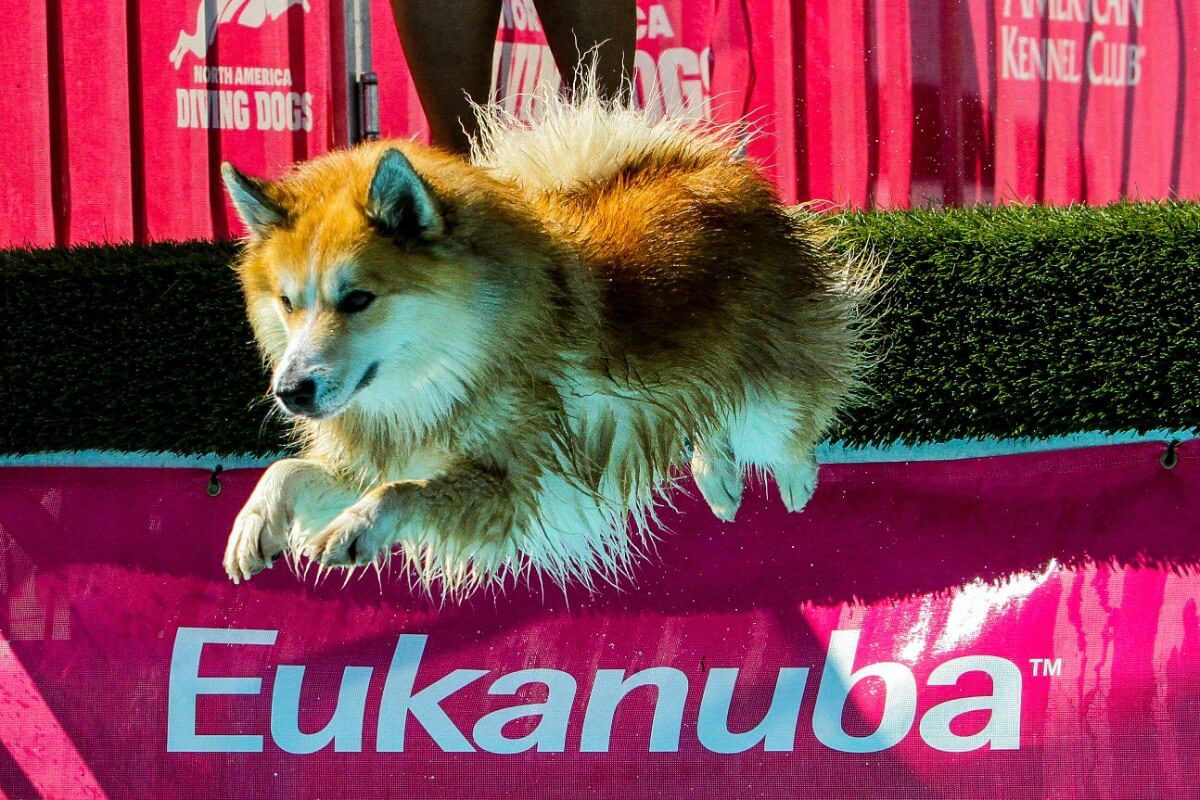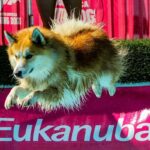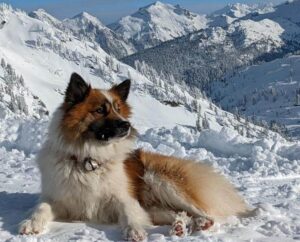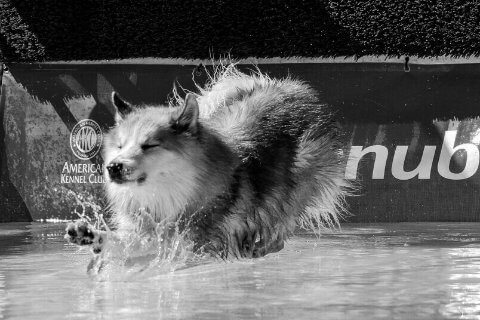
Iceland – Where Cynology is as Pure as Nature Itself
Discover Icelandic Sheepdogs and dog culture in Iceland. Explore breeds, shows, and the passion for dogs in this unique country.
Home » Dog Breeds » Icelandic Sheepdog Dog Breed


The Icelandic Sheepdog, Iceland’s only native purebred, is a lively, intelligent, and affectionate Nordic breed. Known for its agility, herding abilities, and friendly disposition, the “Icie” has served as a loyal companion and working dog in the island nation for centuries. The breed has a keen sense of duty, which has made it useful for herding and guarding livestock, particularly sheep. The breed has a thick double coat, which helps it thrive in colder climates, and its expressive, cheerful demeanor endears it to families and farmers alike.
Herding
16.5 – 18 Inches
25 – 30 Pounds
12 – 14 Years
| Country of Origin | Iceland |
|---|---|
| Bred For | Sheep Herding, Companionship |
| Known For | Friendliness, Confidence, Alertness |
| Popularity | Low |
| Temperament | Confident, Friendly, Lively |
| Activities | Herding, Running, Watchdog, Conformation Shows, Dog Sports |
The Icelandic Sheepdog, with its cheerful disposition and keen herding instincts, boasts a rich history that is intricately tied to the landscapes and culture of Iceland. The breed is believed to have accompanied the Vikings, specifically the Norwegians, on their journey to Iceland over a thousand years ago. Serving as herding dogs, this breed played a crucial role in the agricultural practices of early Icelandic settlers.
With an ancestry that includes dogs from Scandinavia, the Icelandic Sheepdog was adept at handling the harsh weather conditions and challenging terrain of Iceland. The primary historic role of the dogs was to herd sheep, cattle, and horses, showcasing their versatility and endurance. The breed’s distinctive appearance, characterized by its thick coat, pricked ears, and curled tail, was well-suited for the cold Icelandic climate, providing necessary protection against the elements.
Over the centuries, the Icelandic Sheepdog became an integral part of Icelandic culture and farming practices. Their friendly nature and loyalty to their human companions further solidified their status as beloved members of the community. However, the breed has faced challenges, including periods of disease and attempts to reduce the dog population due to concerns over sheep predation. Despite these setbacks, the breed has persevered, with dedicated enthusiasts working tirelessly to preserve and promote its interests.
Official recognition of the breed came about in the 20th century, with it gaining acknowledgment from various kennel clubs and breed organizations. The American Kennel Club (AKC) officially recognized the Icelandic Sheepdog in 2010, a significant milestone that helped to raise awareness and interest in the breed across the United States.
Today, the Icelandic Sheepdog stands as a testament to its rich heritage, embodying the resilience, strength, and companionship that have defined the breed for centuries. Today, the dogs’ role has expanded beyond herding, with many Icies excelling in dog sports, serving as Therapy Dogs, and, most importantly, being cherished as lovable family members. The preservation and celebration of breed’s history remain a priority for breeders and kennel clubs worldwide, ensuring that future generations can experience the joy and companionship of this unique Nordic breed.
Adult male Icelandic Sheepdogs generally stand about 18 inches tall at the shoulder, while mature females are slightly smaller, typically measuring around 16.5 inches in height.
The weight range for males is usually around 30 pounds, whereas females tend to weigh less at around 25 pounds.
The Icelandic Sheepdog presents a rectangular body, with a length that is longer than the height. These dogs possess a robust and muscular build, reflecting their capabilities as a herding breed and watchdog. The chest is deep, extending down to the elbows, and the ribs are well-sprung. The back is level, muscular, and strong. The breed’s substance is solid without appearing heavy, showcasing a harmonious balance that enables these dogs to move with power and agility.
Texture: The Icelandic Sheepdog exhibits a luxurious double coat that is tailored to withstand the challenging Icelandic climate. The breed presents itself in two distinct coat varieties – long-haired and short-haired. Regardless of the length, both varieties possess a dense, water-resistant undercoat that provides insulation from cold temperatures and protects it from wet conditions. The outer coat is fairly coarse on both varieties. It lies down on the back and forms a mane on the neck and shoulders, features that contribute to the breed’s ability to withstand the island’s harsh elements.
| Standard Color | |
|---|---|
| Red & White | ee |
| Black & White | ee |
| Cream & White | ee |
| Gold & White | ee |
| Gray & White | ee |
| Sable & White | ee |
| Tan & White | ee |
| White Tan & Black | ee |
| Chocolate & White | ee |
| Black | ee |
| Chocolate | ee |
| Cream | ee |
| Fawn | ee |
| Golden | ee |
| Gray | ee |
| Red | ee |
| Sable | ee |
| Tan | ee |
| Fawn & White | ee |
| Chocolate & Tan | ee |
| Standard Marking | |
|---|---|
| Black Markings | ee |
| Black Mask | ee |
| Tan Markings | ee |
| Piebald | ee |
| Gray Markings | ee |
| Chocolate Markings | ee |
| Cream Markings | ee |
| WhiteMarkings | ee |
| Reddish Brown Markings | ee |
A Note About Color: Several coat colors are acceptable in the breed and all are accompanied by white markings. These markings may be irregular and are most commonly found on the face, collar, chest, socks, and tip of the tail. A black mask and black tips are sometimes seen on tan and gray dogs. Tri-colored dogs have tan points on the cheeks, over the eyes, and on the legs. Pied dogs are acceptable, although the white should not be predominant.
The Icelandic Sheepdog has a high-set tail that is abundantly covered with hair, contributing a very busky appearance. In moments of alertness or excitement, the tail curls and touches the back. A saber-like tail is unacceptable in the breed. When relaxed, the tail may hang casually, but it should return to a curl when the dog is moving.
The tail is an important feature of the breed and is never docked. Its natural length and fullness are essential for maintaining the breed’s usefulness as a herder in cold climates and for honoring its rich and ancient heritage.
The lively and affectionate Icelandic Sheepdog has captured the hearts of many dog lovers around the world. However, as with any dog, there are certain responsibilities and considerations that come with ownership that will encourage a harmony for both the dog and its human family.
The Icelandic Sheepdog is generally robust, with a resilient constitution that speaks to its herding heritage. Nevertheless, as is the case with all dogs, there are certain health conditions to which individuals of the breed may be predisposed. Potential owners should be mindful of these conditions and work in close partnership with both a reputable breeder and a veterinarian to safeguard the health of their dog.
Lifespan: On average, the lifespan of an Icelandic Sheepdog ranges from 12 to 15 years. With appropriate care, routine veterinary exams, and a balanced diet, many can live to the upper end of this range.
Icelandic Sheepdogs are generally robust and healthy, but like all breeds and mixed breeds, they can be susceptible to certain health conditions. Being aware of these potential risks is crucial for prospective owners who aim to provide the best possible care. Some of the issues that can affect the breed include:
Ensuring that the Icelandic Sheepdog undergoes regular veterinary check-ups is vital for early detection and effective management of these and other health conditions.
The Icelandic Sheepdog is known for its friendly, energetic, and affectionate personality. These dogs form strong bonds with their human companions and are generally great with children, making them an excellent choice as a family companion. Their herding instincts can sometimes lead to them trying to herd other pets or even people, but this is typically done in a gentle manner.
These dogs are intelligent and eager to please, which can make them relatively easy to train. Their energy and enthusiasm, however, requires a patient and consistent training approach. Icelandic Sheepdogs tend to get along well with other dogs, but as with any dog, early socialization is key to ensuring they are well-adjusted and comfortable in a variety of situations.
While they can tolerate being alone for short periods, Icelandic Sheepdogs are social animals that thrive on interaction and companionship. They are not well-suited to being left alone for extended periods of time, and they can become bored or anxious if they do not have enough to do. Providing them with toys, puzzles, and other forms of mental stimulation can help to keep them happy and engaged.
In terms of their approach to strangers, Icelandic Sheepdogs can be friendly and welcoming, but they are also protective of hearth and home. They are likely to bark when someone approaches their property, which makes them good watchdogs. However, they are not typically aggressive and will usually warm up to strangers once they realize there is no threat.
Overall, the Icelandic Sheepdog is a joyful, loving, and active breed that can make a wonderful addition to the right home. These attractive dogs require regular exercise, mental stimulation, and plenty of love and attention from their human companions to thrive. In return, they offer an endless supply of loyalty, companionship, and affection.
Proper nutrition plays a critical role in the health and well-being of an Icelandic Sheepdog. These energetic dogs require a balanced diet rich in proteins, fats, and carbohydrates to support their active lifestyle. It is crucial to choose high-quality commercial dog food or consult with a veterinarian for a homemade diet that meets their nutritional needs.
When it comes to feeding puppies, it is recommended to divide their daily food intake into three to four smaller meals. Puppies have smaller stomachs and higher energy requirements, so more frequent meals help support their growth and development. Adult Icelandic Sheepdogs, on the other hand, can be fed twice a day.
The amount of food an Icelandic Sheepdog requires depends on their age, size, metabolism, and activity level. On average, an adult Icelandic Sheepdog may require 2 to 3 cups of dry dog food per day. However, this is a general guideline, and it’s essential to monitor your dog’s condition and adjust their food intake as necessary to maintain a healthy weight.
Obesity can be a significant health problem in dogs, and it’s important to avoid overfeeding. Treats can be an essential aid in training, but giving too many can cause obesity. Learn about which human foods are safe for dogs, and which are not. If you have any concerns about your dog’s weight or diet, consult with a veterinarian.
Ensuring access to fresh, clean water at all times is also vital for your dog’s health. Staying hydrated is crucial, especially for active breeds like the Icelandic Sheepdog.
The Icelandic Sheepdog is known for its intelligence and eagerness to please, making training a generally rewarding experience. However, this breed also possesses a strong herding instinct and may attempt to herd people, especially children, and other animals. Early socialization and obedience training are crucial to channel their energy positively and prevent undesirable behaviors.
These dogs respond well to positive reinforcement techniques, such as praise, treats, and play. Harsh training methods are not suitable for this breed, as they are sensitive and can become discouraged if treated harshly. Consistency and patience are key when training an Icelandic Sheepdog.
Barking is a natural behavior for the Icelandic Sheepdog, and they can be quite vocal. They tend to bark to alert their owners of anything unusual, and while this can be beneficial, it’s important to teach them to stop barking on command. This ensures that their vocalizations do not become a nuisance.
The breed’s intelligence means they are quick learners, but they also require mental stimulation to prevent boredom. Puzzle toys, games, and training sessions can provide the necessary mental exercise.
Though they do not have a strong wanderlust potential, their herding instinct may kick in if they see something that catches their interest. A secure, fenced yard and leash training are important to keep them safe and prevent them from chasing after moving objects.
In terms of predation, the Icelandic Sheepdog has a moderate prey drive. While they can live harmoniously with other pets, introducing them slowly and supervised is essential, especially with smaller animals.
The Icelandic Sheepdog is a breed brimming with energy and vitality, necessitating ample exercise to maintain their physical and mental well-being. Their heritage as working dogs is evident in their stamina and enthusiasm for activity.
| Energy Level | Medium-High |
|---|---|
| Exercise Requirements | 1 Hour/Day (Minimum), Daily Walks, Vigorous Running, Regular Exercise, Playing with Another Dog, Mental Stimulation |
Engaging the Icelandic Sheepdog in daily exercise routines is paramount. A combination of walks, play sessions, and mentally stimulating activities will help channel their energy positively. This breed exhibits a high energy level, thriving on activities that keep them moving and engaged.
The intensity of their exercise should match their high energy levels. Activities like hiking, running, and agility training are excellent ways to expend their energy and provide the necessary physical stimulation. Icelandic Sheepdogs also show a natural aptitude for herding, and participation in herding trials can be a great way to engage their instincts and provide exercise.
Playfulness is a prominent trait in Icelandic Sheepdogs, and they enjoy interactive games with their human companions. Fetch, tug-of-war, and puzzle toys can keep them entertained and mentally sharp.
Incorporating exercise into the daily routine is crucial, as a lack of physical activity can lead to boredom and potentially destructive behaviors. Providing a variety of activities and consistent exercise routines will ensure that the Icelandic Sheepdog remains happy, healthy, and well-behaved.
Owners should be mindful of the physical demands on puppies and young dogs, as their growing bodies are more susceptible to injury. Adjusting exercise intensity and duration to suit their development stage is essential.
The Icelandic Sheepdog, with its thick double coat, requires regular grooming to maintain its health and appearance. This breed experiences seasonal shedding, and during these periods, more frequent brushing is necessary to remove loose fur and prevent matting.
| Coat Type | Double Coat, Thick, Weatherproof |
|---|---|
| Grooming Requirements | Weekly Brushing, Occasional Bathing, Routine Ear Cleaning, Periodic Nail Trimming, Regular Tooth Brushing |
Despite their abundant coat, Icelandic Sheepdogs are relatively easy to groom. A weekly brushing routine suffices for most of the year, helping to distribute natural oils, keep the coat clean, and reduce shedding. During shedding seasons, which typically occur in spring and fall, daily brushing becomes essential to manage the increased volume of loose hair.
Their coat does not tend to hold dirt and debris, and Icelandic Sheepdogs are known for being clean dogs. Baths are required only occasionally, depending on the dog’s lifestyle and exposure to dirt. Overbathing should be avoided, as it can strip the coat of its natural oils, leading to dryness and irritation.
Apart from coat care, routine maintenance tasks such as nail trimming, ear cleaning, and dental care are vital. Regular nail trims prevent painful overgrowth and cracking. Checking the ears weekly for signs of infection, irritation, or wax buildup and cleaning them as needed helps maintain ear health. Implementing a dental care routine, including brushing and providing dental chews, contributes to overall health and prevents dental issues.
Incorporating grooming into their routine from a young age helps them become accustomed to the process, making it a positive experience for both the dog and the owner. It also provides an opportunity to check for any signs of health issues, such as skin problems, lumps, or infections, ensuring early detection and intervention.
The Icelandic Sheepdog is a versatile breed that adapts well to various living environments, but there are specific considerations to ensure they thrive in their home.
When it comes to apartment living, Icelandic Sheepdogs can adapt if their exercise and mental stimulation needs are met. However, their tendency to be vocal could pose a challenge, making training to manage barking essential. A quiet command and providing ample activities to keep them engaged can help mitigate excessive barking.
This breed possesses a thick double coat that provides ample protection in cold weather, making them well-suited to cooler climates. They enjoy playing in the snow, and their energy levels make them enthusiastic participants in winter activities. However, it’s important to provide shelter and warmth during extremely low temperatures to ensure their safety and comfort.
In contrast, their thick coat can make them prone to overheating in hot weather. Providing shade, fresh water, and limiting exercise during the hottest parts of the day are crucial to prevent heatstroke. Owners might also consider indoor activities or water play to help keep them cool.
The breed’s playful and energetic nature makes them excellent companions for active individuals or families. Their affectionate and friendly demeanor means they usually get along well with children, provided interactions are supervised, and children are taught how to interact respectfully with dogs.
Welcoming a litter of Icelandic Sheepdog puppies into the world is an exciting adventure that is filled with much joy and a few challenges. These puppies are known for their playful, energetic, and affectionate nature, making them delightful partners as working dogs and companions in the home.
From the moment they arrive, these puppies require proper care, attention, and training to ensure they grow into well-adjusted and healthy adult dogs. Socialization is only one crucial aspect of their development. Exposing them to various people, environments, and situations in a positive and controlled manner helps in building their confidence and molding their temperament.
Caring for an Icelandic Sheepdog puppy entails meeting its specific nutritional, exercise, and healthcare needs. Providing a balanced diet that is formulated for puppies is vital for growth and development. It is important to feed the appropriate amount as indicated for the pup’s age, size, and activity level, and to provide several smaller-sized meals each day.
Exercise is an integral part of any puppy’s routine, but it is important to remember that a growing body is susceptible to injury. It is best to engage the pup in gentle play sessions and short walks, avoiding high-impact activities until it is fully grown. As the puppy matures, increases in the duration and intensity of exercise can be implemented.
Regular veterinary check-ups are essential to monitor the puppy’s development, administer vaccinations, and address any potential health issues early on. Establishing a grooming routine from a young age will help it to become accustomed to being handled and will ensure the pup’s coat remains in top condition.
Training and socialization should start early, utilizing positive reinforcement methods to encourage good behavior and build a strong bond between the Icelandic sheepdog puppy and its family. Although the pup is intelligent and eager to please, making it responsive to training, it also has an independent streak that requires patience and consistency.
The Icelandic Sheepdog is an energetic and intelligent breed that participates in many dog sports. Engaging in these activities not only provides the dog with the physical exercise it needs, it also offers mental stimulation that is crucial for the breed. Below is a list of activities and dog sports that are well-suited for the Icelandic Sheepdog:
By participating in these activities and dog sports, Icelandic Sheepdog handlers can provide their companions with the physical exercise, mental stimulation, and social interaction they need to thrive. Additionally, it strengthens the bond between dog and handler, making for a fulfilling and enjoyable experience for both.
The Icelandic Sheepdog is recognized by the world’s leading registries and kennel organizations, which categorize the breed into a specific Group based on its unique characteristics. This breed is recognized worldwide under the following Group designations:
| Organization | Group Designation |
|---|---|
| AKC (American Kennel Club) | Herding |
| UKC (United Kennel Club) | Herding Dog |
| CKC (Canadian Kennel Club) | Herding |
| ANKC (Australian National Kennel Council) | Working Dogs |
| RKC (The Royal Kennel Club) | Not Recognized |
| FCI (Fédération Cynologique Internationale) | Group 5: Spitz and Primitive Types; Section 3.4: Nordic Watchdogs and Herders |
The ideal Icelandic Sheepdog is described by a Breed Standard that is approved by each of the world’s leading registries and kennel organizations. The Breed Standards for this breed may be found in the following links:
| Organization | Breed Standard |
|---|---|
| American Kennel Club | AKC Icelandic Sheepdog Breed Standard |
| United Kennel Club | UKC Icelandic Sheepdog Breed Standard |
| Canadian Kennel Club | CKC Icelandic Sheepdog Breed Standard |
| Australian National Kennel Council | ANKC Icelandic Sheepdog Breed Standard |
| The Royal Kennel Club | Not Recognized |
| Fédération Cynologique Internationale | FCI Icelandic Sheepdog Breed Standard |
Icelandic Sheepdog clubs play a vital role in supporting and promoting the breed, providing resources for breeders, owners, and enthusiasts. These clubs often facilitate opportunities for socialization, training, and participation in breed-specific events.
In the United States, the Icelandic Sheepdog Association of America (ISAA) serves as a central hub for individuals interested in the breed. The ISAA works diligently to protect and advance the interests of the breed through education, responsible breeding practices, and participation in dog shows and other canine events.
Canada also has a dedicated club. Founded in 2001, the Canadian Icelandic Sheepdog Club fosters a community of Icelandic Sheepdog owners and breeders and promotes responsible ownership and breeding practices.
These clubs, along with others worldwide, are instrumental in preserving the breed’s heritage and ensuring its future. They offer a wealth of knowledge and support for anyone looking to learn more about the breed, consider bringing an Icelandic Sheepdog into their home, or participate in breed-specific activities.
The Icelandic Sheepdog is a relatively rare breed, and as such, there are limited breed-specific rescue groups dedicated solely to their welfare. However, this does not diminish the importance of adoption and rescue when considering bringing an Icelandic Sheepdog into your home.
In the United States, the Icelandic Sheepdog Association of America (ISAA) may have resources or contacts for rescue and rehoming Icelandic Sheepdogs in need. Interested individuals can reach out to the association to inquire about available dogs or to express their willingness to provide a forever home to an Icelandic Sheepdog.
Icelandic Sheepdogs are not considered hypoallergenic. They have a dense double coat that sheds, particularly during the change of seasons, which can trigger reactions in sensitive individuals. To ensure they can tolerate the dander, it is crucial for potential owners with allergies to spend time around the breed before making a commitment.
Icelandic Sheepdogs are known for their vocal nature. They were bred to work on farms and in rugged terrain where communication was key, This resulted in a breed that tends to bark to express itself and alert its family, or simply from the joy of playing. Proper training and socialization from a young age can help to manage excessive barking.
Yes, Icelandic Sheepdogs shed. They possess a thick double coat that requires regular grooming to manage the shedding and to maintain the overall health of the coat. Seasonal shedding is particularly noticeable, however, and during these times additional grooming may be necessary to keep the coat in top condition.
Icelandic Sheepdogs are intelligent and eager to please, making them relatively easy to train. They respond well to positive reinforcement and consistent training methods. Early socialization and obedience training are crucial for harnessing their intelligence and to ensure they develop into well-behaved adults.
With proper introductions and socialization, Icelandic Sheepdogs can get along well with cats. Their herding instinct may kick in, it should be noted, leading these dogs to try and herd the cats. However, with training, this behavior can be managed. It is important to supervise initial interactions to make sure a positive relationship has been established.
While Icelandic Sheepdogs are active and enjoy space to roam and play, they can adapt to apartment living if their exercise needs are met. They do require regular activity, mental stimulation, and engagement with their family members. Apartment dwellers should be prepared to provide ample outdoor activities to keep the dog happy and healthy.
Icelandic Sheepdogs are generally robust and do not have a reputation for having particularly sensitive stomachs. However, like all dogs, individuals may have specific dietary needs or sensitivities. Providing a balanced diet and monitoring for any signs of digestive upset is important for a dog’s overall health.
Icelandic Sheepdogs have a lifespan of around 12 to 14 years, although some individuals can live longer with proper care. Their longevity is influenced by factors such as genetics, diet, exercise, and regular veterinary care. Providing a healthy and loving environment is likely to contribute to a longer and healthier life.

Discover Icelandic Sheepdogs and dog culture in Iceland. Explore breeds, shows, and the passion for dogs in this unique country.

Interview with Herding Group Breeders Jo-Ann Secondino & Jonathan Pickett – My partner, Jon, and I have been raising Icelandic Sheepdogs for

Discover Icelandic Sheepdogs and dog culture in Iceland. Explore breeds, shows, and the passion for dogs in this unique country.

Interview with Herding Group Breeders Jo-Ann Secondino & Jonathan Pickett – My partner, Jon, and I have been raising Icelandic Sheepdogs for
The best way to ensure a long and happy relationship with a purebred dog is to purchase one from a responsible breeder. Not sure where to begin?
Contact the National Parent Club’s Breeder Referral Program, which is listed on the AKC Breeder Referral Contacts page.


"*" indicates required fields
Showsight Magazine–the world’s most influential purebred dog publication since 1992. Each issue reaches a global audience dedicated to preserving the history and health of purpose bred dogs. Filled with award-winning editorial focused on news and insights from the dog show community, top breeders, handlers, AKC Judges, and more!